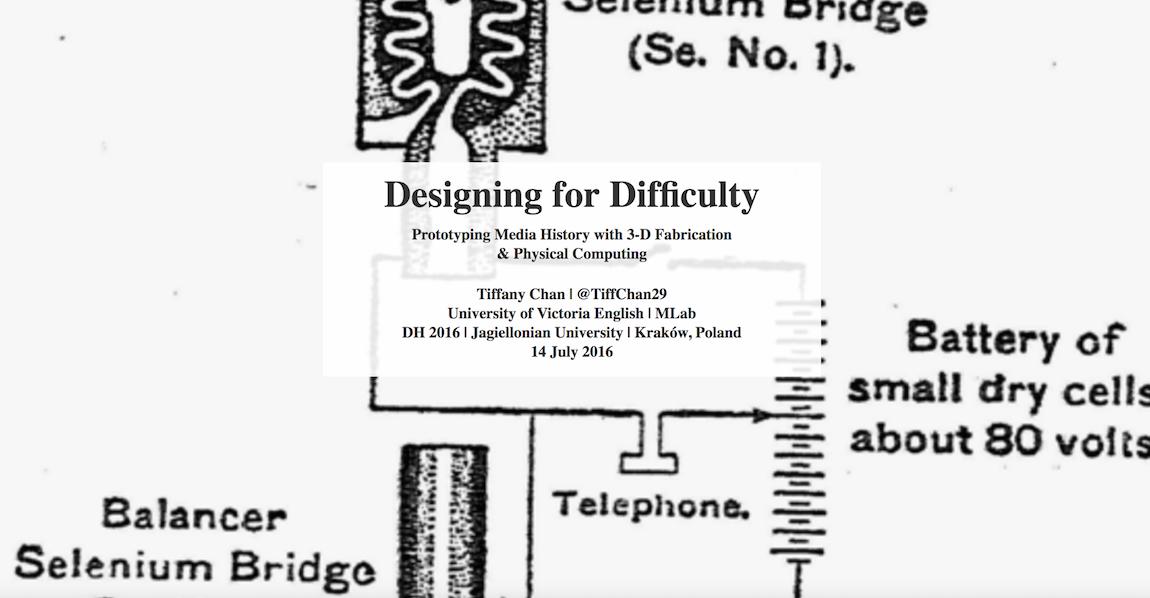As part of our Kits for Cultural History (KCH) project (supported by the Social Sciences and Humanities Research Council of Canada), I am speaking at Digital Humanities 2016 in Kraków, Poland this week. Here are my slides for the talk, and below is the first slide together with my references. The talk addresses all three projects in the KCH series (early wearables, early magnetic recording, and early optophonics); however, it focuses on the reading optophone, which I’ve been developing in the lab during the last few months. It is an honour to present for the first time at the annual Digital Humanities conference, and I’ll publish more about the reading optophone soon.
Chan, Tiffany, Victoria Murawski, and Jentery Sayers. “Remaking Optophones: An Exercise in Maintenance Studies.” Gayle Morris Sweetland Centre for Writing, 14 Mar. 2016. Web. https://www.digitalrhetoriccollaborative.org/2016/03/14/remaking-optophones-an-exercise-in-maintenance-studies/
Cooper, Franklin S., Jane H. Gaitenby, and Patrick W. Nye. “Evolution of Reading Machines for the Blind: Haskins Laboratories’ Research as a Case History.” Journal of Rehabilitation Research & Development 21.1 (1984): 51-87. Web. https://www.haskins.yale.edu/Reprints/HL0455.pdf
Fournier d’Albe. The Moon Element: An Introduction to the Wonders of Selenium. New York: D Appleton and Company, 1914. Web. https://archive.org/details/moonelement002067mbp
Hendren, Sara. “All Technology is Assistive: Six Design Rules on ‘Disability’.” Backchannel. Medium.com. https://backchannel.com/all-technology-is-assistive-ac9f7183c8cd
Jameson, Mary. “The Optophone: Its Beginning and Development.” The Sixth Technical Conference on Reading Machines for the Blind. 27-28 Jan. 1966, Washington, D.C. Bulletin of Prosthetics Research, 1966. Web. https://www.rehab.research.va.gov/jour/66/3/1/25.pdf
—. “The Optophone or How the Blind May Read Ordinary Print by Ear.” …And There Was Light 1.4 (1932): 19-22. Web. https://archive.org/stream/andtherewasli01unse#page/18/mode/2up
Mills, Mara. “Optophones and Musical Print.” Sounding Out (2015): n.pag. Web. https://soundstudiesblog.com/2015/01/05/optophones-and-musical-print/
Morgan, Danielle. “Jacob: Recording on Wire.” Maker Lab in the Humanities. MLab (University of Victoria), 2 Jun. 2016. Web. ./jacob/
Rubery, Matthew. “‘How We Read’: The Optophone.” Online video clip. YouTube. YouTube, 23 Aug. 2015. Web. https://www.youtube.com/watch?v=w0wuIv1JVGU
—. “Reading Machines.” How We Read: A Sensory History of Books for Blind People. 2016. Web. https://www.howweread.co.uk/gallery/reading-machines/
Sayers, Jentery. “Kits for Cultural History.” Hyperrhiz 13 (2015): n.pag. Web. https://hyperrhiz.io/hyperrhiz13/
—. “Prototyping the Past.” Visible Language 49.3 (2015): n.pag. Web. https://visiblelanguagejournal.com/issue/172/article/1232
—. “Why Fabricate?” Scholarly Research and Communication 6.3 (2015): n. pag. Web. https://src-online.ca/index.php/src/article/view/209/428
Post by Tiffany Chan, attached to the KitsForCulture project, with the physcomp, news, and fabrication tags. Featured image care of DH 2016. Thanks to Robert Baker (Blind Veterans UK), Mara Mills (New York University), and Matthew Rubery (Queen Mary University of London) for their support and feedback on this research. Research conducted with Katherine Goertz, Danielle Morgan, Victoria Murawski, and Jentery Sayers.


